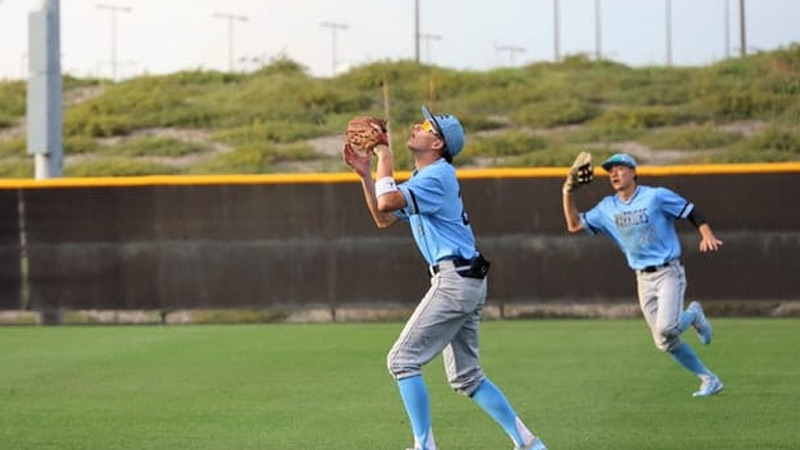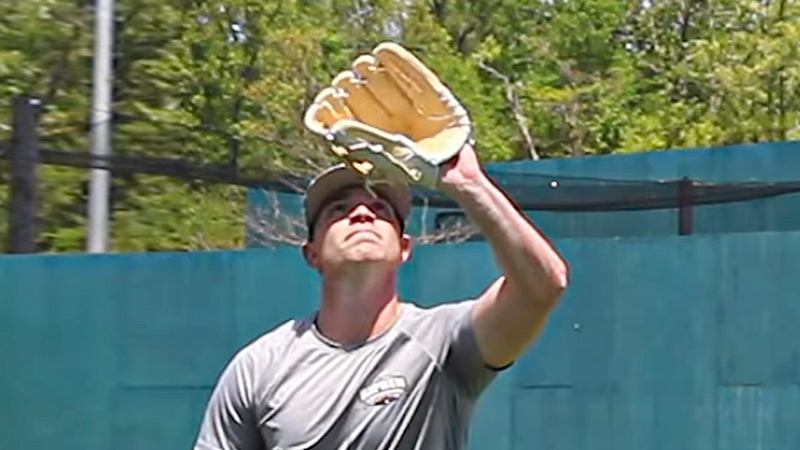Catching a fly ball in the outfield is one of the most crucial and exciting moments in a baseball game. As an outfielder, it’s your responsibility to cover a vast amount of territory and make difficult catches to help your team secure outs.
However, it can be a challenging skill to master. To improve your fly ball-catching abilities, here’s how to catch a fly ball and some essential tips for baseball outfielders.
How to Catch a Fly Ball?
Here are some effective tips on how to catch a fly ball-
1. Positioning The Ball
Positioning refers to the placement of the fielder in relation to the fly ball’s trajectory. Proper positioning allows you to get into the best possible spot to make the catch.
Key aspects of positioning include:
Anticipation
As the batter makes contact with the ball, you must anticipate where the ball is likely to go based on factors such as the hitter’s swing, pitch type, and field conditions. This anticipation helps you move to the optimal spot before the ball is in the air.
Angle and Depth
Based on your anticipation, you need to position yourself at an appropriate angle and depth from the outfield fence or the infield to be in the best position to make the catch. This involves judging the ball’s trajectory and speed accurately.
Communication
If you’re part of an outfield team, effective communication with your fellow fielders is vital. Calling out your intentions and communicating the positioning with your teammates helps avoid collisions and ensures that someone is in the best position to catch the ball.
2. Readiness The Ball

Source: mlive.com
Readiness refers to being mentally and physically prepared to catch the fly ball. It involves several aspects:
Focus
Maintaining concentration and focus throughout the play is crucial. You should be tracking the flight of the ball and not be distracted by other elements on the field or in the crowd.
Body Position
Your body should be in an athletic stance, ready to react and move quickly. Keep your knees slightly bent, weight balanced on the balls of your feet, and your glove in a position to make the catch.
3. Tracking the Ball
As the ball is in flight, you must track it with your eyes, continuously adjusting your position and route to the ball if necessary. Tracking the ball allows you to judge its speed, height, and direction accurately.
Adjustments
Depending on the ball’s trajectory, wind conditions, and other factors, you may need to make last-minute adjustments to your positioning and route. Staying ready to make these adjustments ensures you are in the optimal position to catch the ball.
By combining proper positioning with readiness, you maximize your chances of successfully catching a fly ball in baseball. These skills come with experience, practice, and a deep understanding of the game’s dynamics.
Accuracy
Tracking the ball allows you to accurately judge its speed, height, and direction. This information is vital for positioning yourself correctly and timing your jump or catch. Without proper tracking, you may misjudge the ball’s path, leading to errors or missed catches.
Adjustments
As the ball is in flight, it can be affected by various factors such as wind, spin, and trajectory. By tracking the ball, you can anticipate and make necessary adjustments to your positioning and route to ensure you are in the best position to make the catch.
Adjustments might involve taking a few steps back, moving to the left or right, or adjusting your angle.
4. Focus and Concentration The Ball
Tracking the ball requires intense focus and concentration. It helps you stay fully engaged in the play and avoids distractions that could hinder your ability to make the catch.
By keeping your eyes locked on the ball, you can block out peripheral distractions and maintain optimal concentration throughout the play.
Timing
Proper tracking enables you to gauge the timing required to make the catch. You can anticipate the ball’s arrival and plan your actions accordingly. Timing is crucial because catching a fly ball requires precise coordination between your movements and the ball’s trajectory.
By tracking the ball effectively, you can time your jump or extend your glove at the right moment to make a successful catch.
Confidence
Tracking the ball effectively instills confidence in your abilities. When you can visually follow the ball’s path and make accurate judgments, you feel more in control of the play.
This confidence can positively impact your performance, allowing you to make more challenging catches and reduce the likelihood of errors.
5. Communication The Ball

Source: protips.dickssportinggoods.com
Communication plays a vital role when catching a fly ball in baseball, especially when multiple fielders are involved. Effective communication helps prevent collisions, ensures the appropriate fielder makes the catch and facilitates teamwork.
Here’s why communication matters:
Avoiding Collisions
When multiple fielders are converging on a fly ball, communication is crucial to prevent collisions. Outfielders and infielders need to communicate their intentions to avoid running into each other while tracking the ball.
By calling out loudly and clearly, fielders can alert each other to their position and prevent potential accidents.
Establishing Responsibility
In situations where multiple fielders have a chance to catch the ball, communication helps establish who will make the play. This avoids confusion and hesitation, allowing the designated fielder to take charge and make the catch confidently.
Clear communication ensures that everyone understands their roles and responsibilities, reducing the risk of missed catches or errors due to indecision.
Maximizing Coverage
In the outfield, communication allows fielders to position themselves optimally to cover the maximum area. By communicating their positioning and adjusting based on the flight of the ball, outfielders can ensure that every part of the field is covered effectively.
This coordination prevents gaps in coverage and increases the chances of making successful catches.
Providing Support
Communication also serves to provide support and encouragement to fielders. In high-pressure situations, such as a difficult fly ball or a long run to make a catch, positive reinforcement from teammates can boost confidence and focus.
By communicating words of encouragement or offering assistance, teammates can help fielders maintain their composure and perform at their best.
Anticipating Challenges
Through effective communication, fielders can alert each other to potential challenges related to the ball’s trajectory, wind conditions, or other factors. Sharing information and observations can help fielders anticipate difficulties and make necessary adjustments in positioning or route. This shared awareness allows the fielders to work together as a cohesive unit, increasing the chances of making the catch successfully.
Team Cohesion
Communication fosters teamwork and cohesion among fielders. By actively communicating and supporting each other during fly ball situations, fielders develop trust and synergy. This cohesion contributes to a smoother and more efficient fielding process, enhancing the overall performance of the team.
6. Proper Footwork

Source: baseballtrainingworld.com
Proper footwork is crucial when catching a fly ball in baseball. It helps fielders establish a solid foundation, maintain balance, and position themselves optimally to make the catch.
Here’s why track and proper footwork matter:
Establishing A Stable Base
By employing proper footwork, fielders can establish a stable and balanced foundation. This involves positioning their feet shoulder-width apart, with their weight evenly distributed on the balls of their feet.
A stable base allows fielders to react quickly, maintain control, and make precise movements while tracking the ball.
Reacting to the Ball’s Trajectory
As the ball is in flight, its trajectory may change due to factors like wind, spin, or the batter’s swing. Proper footwork enables fielders to adjust their positioning in response to these changes.
By quickly moving their feet, fielders can reposition themselves to track the ball accurately and be in the best position to make the catch.
Efficient Route Running
When tracking a fly ball, fielders need to take the most direct route to reach the ball’s landing spot. Proper footwork helps fielders navigate the field effectively, minimizing the distance they need to cover and ensuring they reach the ball efficiently.
By utilizing quick, precise footwork, fielders can maximize their speed and reduce the time it takes to reach the intended spot.
Adjusting to Speed and Distance
The speed and distance of a fly ball can vary, requiring fielders to adjust their footwork accordingly. For high-flying balls, fielders may need to move backward, while for shallow pop-ups, they might need to move forward or to the side.
Proper footwork allows fielders to react and adjust their position swiftly based on the ball’s speed and distance, ensuring they are in the optimal spot to make the catch.
Body Alignment and Glove Positioning
Proper footwork contributes to correct body alignment and glove positioning when preparing to catch the ball. By using their footwork to position themselves under the ball’s flight path, fielders can align their body and glove appropriately, making it easier to catch the ball securely.
This alignment enhances the fielder’s reach and reduces the chances of the ball eluding their grasp.
Momentum and Throwing Mechanics
Once the fly ball is caught, proper footwork helps fielders transition smoothly into their throwing motion. By employing efficient footwork, fielders can generate momentum, transfer their weight, and position themselves for an accurate and powerful throw.
This footwork is particularly important for outfielders, who often need to make strong throws back to the infield after making a catch.
7. Practice and Repetition
Repetition is key to becoming a proficient outfielder. Incorporate various fly ball drills into your practice routine, such as tracking balls hit from different angles, adjusting to different speeds and distances, and catching balls in simulated game situations.
The more you practice, the better your instincts and reactions will become.
FAQ
How do I overcome the fear of misjudging a fly ball?
Misjudging a fly ball can be intimidating, but with practice and experience, you can build confidence. Focus on tracking the ball off the bat, using visual cues to determine its trajectory, and positioning yourself well.
What should I do if a fly ball is hit directly into the sun?
Fielding fly balls in the sun can be challenging. To handle such situations, position yourself with your non-glove side facing the sun. Use your glove to shade your eyes while keeping them on the ball.
How do I communicate with other outfielders when going for a fly ball?
Communication is crucial to avoid collisions and ensure that the appropriate fielder makes the catch. Use clear and concise verbal cues, such as calling “I got it!” or “You take it!” to let your teammates know your intention.
What if the wind affects the trajectory of the fly ball?
When dealing with wind-affected fly balls, it’s important to read the wind’s direction and intensity before the pitch. Anticipate how it might impact the ball’s flight path. Adjust your positioning accordingly and be prepared to make quick adjustments as the ball is in the air.
Are there any specific drills I can do to improve my fly ball-catching skills?
Yes, there are several drills that can help you improve your fly ball-catching abilities. Some examples include the tracking drill, sun drill, positioning drill, communication drill, and sun drill.
Final Words
So, now you know how to catch a fly ball. Remember, catching fly balls requires a combination of skill, focus, and practice. By following these tips and dedicating yourself to improving your outfield play, you can become a reliable and effective fly ball-catching outfielder.
So step onto the field, keep your eyes on the ball, and make those incredible catches that contribute to your team’s success.







